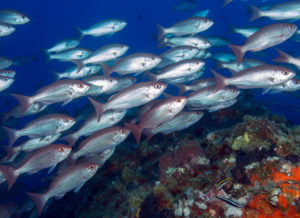BSIA stands for “best scientific information available.” It’s a term used often when making important fisheries management decisions, so it’s helpful to define BSIA, summarize how it is determined, and specify who decides what is BSIA.

What is BSIA?
The Magnuson-Stevens Fishery Conservation and Management Act (The Magnuson-Stevens Act) governs modern fisheries management and includes ten National Standards. These National Standards are statutory principles that must be followed in any fishery management plan and serve as a guide for the fishery management process. NOAA Fisheries has published guidelines, based on the national standards, to assist in the development and review of fishery management plans, amendments, and regulations. National Standard 2 specifically addresses BSIA. It states: “Conservation and management measures shall be based upon the best scientific information available.” The National Standard 2 Guidelines outline specific criteria to consider when evaluating BSIA: relevance, inclusiveness, objectivity, transparency and openness, timeliness, verification and validation, and peer review[1]. The National Standard 2 Guidelines give ample information on what constitutes BSIA, yet the process for recommending BSIA is largely left up to the individual regional fishery management councils.
Who Determines BSIA and what is the general process?
You might be wondering who ultimately determines BSIA and how it’s used in fishery management decisions. As required by the Magnuson-Stevens Act, all conservation and management measures, including stock status determinations and harvest limits must be based on BSIA, with the final decision on what constitutes BSIA made by NOAA Fisheries. Stock status determinations (i.e., overfished and overfishing), and catch limits and harvest specifications (i.e., acceptable biological catch) are all examples of aspects of fisheries management that are evaluated for BSIA.
The process begins with data that are used in stock assessments. A panel of experts review relevant scientific studies on a species and determines which ones are scientifically rigorous enough to be included in the assessment. Then, the assessment undergoes technical and peer-review before a stock status determination is made by NOAA Fisheries. NOAA Fisheries is also charged with recording stock assessment results, and if appropriate, asserts that an assessment constitutes BSIA.
What role does the Scientific and Statistical Committee play in recommending BSIA?
The Scientific and Statistical Committee (SSCs) is the scientific advisor for the Council and plays a vital role in recommending BSIA. Scientific & Statistical Committee Members are stock assessment or quantitative biologists/ecologists, economists, quantitative anthropologists/sociologists, and other scientists who are knowledgeable about the technical aspects of fisheries in the Gulf of Mexico. The SSCs can make recommendations during the stock assessment process, during meetings when reviewing scientific materials useful for management, and when stock assessments have been completed. Often, the SSCs discuss potential uncertainties in the assessment before making recommendations for management. Once the SSCs make a recommendation on BSIA, typically catch level advice and other stock status criteria for management follows. The newly populated Standing and Special Scientific and Statistical Committee will be meeting August 9-11, 2021, and will be reviewing a draft document outlining a Proposed Best Practices and Voting Procedures, which are in keeping with National Standard 2 and the Magnuson-Steven Act. For more detailed information on the process they will be discussing, follow this link: https://gulfcouncil.org/wp-content/uploads/VI.-Draft-Text-SSC-Voting-Best-Practices-and-Procedures-for-SOPPs_v5.pdf
What does NOAA Fisheries do with the management recommendations made by the Council?
All Council actions are reviewed by NOAA Fisheries for approval and implementation. During that process, NOAA Fisheries considers whether the proposed actions are consistent with the Magnuson-Stevens Act, including the BSIA requirement. The Southeast Fisheries Science Center reviews all Council Amendments to Fishery Management Plans or Framework Actions before they are transmitted to the Secretary of Commerce and subsequently provides a memo of certification or feedback and edits for improvement to achieve a BSIA determination. NOAA Fisheries then makes a stock status determination based on final assessment results and the Council’s Amendments to Fishery Management Plans or Framework Actions that are developed to implement the results of the stock assessment.
